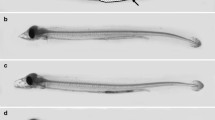Abstract
The efficiency of a new liquid-type diet for long-term rearing of Japanese eel larvae until metamorphosis was examined, as was the effect of diet viscosity on diet intake and on the survival and growth of early larvae. The highest intake of the experimental diet by 6- and 9-day post-hatch (dph) larvae occurred at viscosities of 20–50 mPa·s, much lower than the viscosity of the currently used slurry-type diet (ca. 2900 mPa·s). Long-term feeding trials for 259 days (n = 4) showed that overall survival rates of larvae (37–59%) fed a liquid-type diet with lower viscosity (40–680 mPa·s) were 2 to 3.4 times higher than the survival rates of larvae fed the slurry-type diet (11–25%). Because nutrients were diluted in the liquid-type diet, the growth of larvae fed this diet was slower after about 200 days and metamorphosis was delayed. However, the yield of glass eels was 1.1 to 3.2 times higher in larvae fed the liquid than the slurry diet. These findings suggest that feeding the liquid-type diet can result in the mass production of glass eels by ensuring high growth, survival and metamorphosis rates.






Similar content being viewed by others
References
Bouilliart M, Tomkiewicz J, Lauesen P, De Kegel B, Adriaens D (2015) Musculoskeletal anatomy and feeding performance of pre-feeding engyodontic larvae of the European eel (Anguilla anguilla). J Anat 227:325–340. https://doi.org/10.1111/joa.12335
Feunteun E, Miller MJ, Carpentier A, Aoyama J, Dupuy C, Kuroki M, Pagano M, Réveillac E, Sellos D, Watanabe S, Tsukamoto K, Otake T (2015) Stable isotopic composition of anguilliform leptocephali and other food web components from west of the Mascarene Plateau. Prog Oceanogr 137:69–83. https://doi.org/10.1016/j.pocean.2015.05.024
Horie N, Utoh T, Mikawa N, Yamada Y, Okamura A, Tanaka S, Tsukamoto K (2008) Influence of artificial fertilization methods of the hormone-treated Japanese eel Anguilla japonica upon the quality of eggs and larvae (comparison between stripping-insemination and spontaneous spawning methods). Nippon Suisan Gakkaishi 74:26–35 (in Japanese with English abstract)
Kuroki M, Fukuda N, Yamada Y, Okamura A, Tsukamoto K (2010) Morphological changes and otolith growth during metamorphosis of Japanese eel leptocephali in captivity. Coast Mar Sci 34:31–38
Masuda Y, Oku H, Nomura K, Teruya K, Tanaka H (2010) A colloid-type diet can be ingested by larvae of the Japanese eel Anguilla japonica. J Fish Technol 2:99–104 (in Japanese with English abstract)
May RC (1974) Larval mortality in marine fishes and the critical period concept. In: Blaxter JHS (ed) The early life history of fish. Springer, Berlin, pp 3–19
Miller MJ, Chikaraishi Y, Ogawa NO, Yamada Y, Tsukamoto K, Ohkouchi N (2012) A low trophic position of Japanese eel larvae indicates feeding on marine snow. Biol Lett 9:20120826. https://doi.org/10.1098/rsbl.2012.0826
Mochioka N, Iwamizu M (1996) Diet of anguilloid larvae: leptocephali feed selectively on larvacean houses and fecal pellets. Mar Biol 125:447–452. https://doi.org/10.1007/BF00353257
Ohta H, Kagawa H, Tanaka H, Okuzawa K, Iinuma N, Hirose K (1997) Artificial induction of maturation and fertilization in the Japanese eel, Anguilla japonica. Fish Physiol Biochem 17:163–169
Okamura A, Yamada Y, Mikawa N, Horie N, Utoh T, Kaneko T, Tanaka S, Tsukamoto K (2009a) Growth and survival of eel leptocephali (Anguilla japonica) in low-salinity water. Aquaculture 296:367–372. https://doi.org/10.1016/j.aquaculture.2009.08.039
Okamura A, Yamada Y, Horita T, Horie N, Mikawa N, Utoh T, Tanaka S, Tsukamoto K (2009b) Rearing eel leptocephali (Anguilla japonica Temminck & Schlegel) in a planktonkreisel. Aquac Res 40:509–512. https://doi.org/10.1111/j.1365-2109.2008.02127.x
Okamura A, Yamada Y, Mikawa N, Horie N, Tsukamoto K (2012) Effect of starvation, body size, and temperature on the onset of metamorphosis in Japanese eel (Anguilla japonica). Can J Zool 90:1378–1385. https://doi.org/10.1139/cjz-2012-0146
Okamura A, Yamada Y, Horie N, Mikawa N, Tanaka S, Kobayashi H, Tsukamoto K (2013) Hen egg yolk and skinned krill as possible foods for rearing leptocephalus larvae of Anguilla japonica Temminck & Schlegel. Aquac Res 44:1531–1538. https://doi.org/10.1111/j.1365-2109.2012.03160.x
Okamura A, Horie N, Mikawa N, Yamada Y, Tsukamoto K (2014) Recent advances in artificial production of glass eels for conservation of anguillid eel populations. Ecol Freshw Fish 23:95–110. https://doi.org/10.1111/eff.12086
Otake T, Nogami K, Maruyama K (1993) Dissolved and particulate organic matter as possible food sources for eel leptocephali. Mar Ecol Prog Ser 92:27–34
Riemann L, Alfredsson H, Hansen MM, Als TD, Nielsen TG, Munk P, Aarestrup K, Maes GE, Sparholt H, Petersen MI, Bachler M, Castonguay M (2010) Qualitative assessment of the diet of European eel larvae in the Sargasso Sea resolved by DNA barcoding. Biol Lett 6:819–822. https://doi.org/10.1098/rsbl.2010.0411
Tanaka H (2015) Progression in artificial seedling production of Japanese eel Anguilla japonica. Fish Sci 81:11–19. https://doi.org/10.1007/s12562-014-0821-z
Tanaka H, Kagawa H, Ohta H (2001) Production of leptocephali of Japanese eel (Anguilla japonica) in captivity. Aquaculture 201:51–60. https://doi.org/10.1016/S0044-8486(01)00553-1
Yamada Y, Okamura A, Mikawa N, Utoh T, Horie N, Tanaka S, Miller M, Tsukamoto K (2009) Ontogenetic changes in phototactic behavior during metamorphosis of artificially reared Japanese eel Anguilla japonica larvae. Mar Ecol Prog Ser 379:241–251. https://doi.org/10.3354/meps07912
Yamada Y, Okamura A, Mikawa N, Horie N, Tsukamoto K (2019) A new liquid-type diet for leptocephali in mass production of artificial glass eels. Fish Sci 85:545–551. https://doi.org/10.1007/s12562-019-01295-2
Yoshimatsu T (2011) Early development of preleptocephalus larvae of the Japanese eel in captivity with special reference to the organs for larval feeding. Bull Grad Sch Bioresour Mie Univ 37:11–18
Acknowledgements
This study was partially supported by the research fund from Toyo Suisan Kaisha. Ltd. and JSPS KAKENHI grant numbers JP26450268, 26252030, 17K19300 to KT.
Author information
Authors and Affiliations
Corresponding author
Additional information
Publisher's Note
Springer Nature remains neutral with regard to jurisdictional claims in published maps and institutional affiliations.
Rights and permissions
About this article
Cite this article
Okamura, A., Yamada, Y., Horie, N. et al. Long-term rearing of Japanese eel larvae using a liquid-type diet: food intake, survival and growth. Fish Sci 85, 687–694 (2019). https://doi.org/10.1007/s12562-019-01316-0
Received:
Accepted:
Published:
Issue Date:
DOI: https://doi.org/10.1007/s12562-019-01316-0




